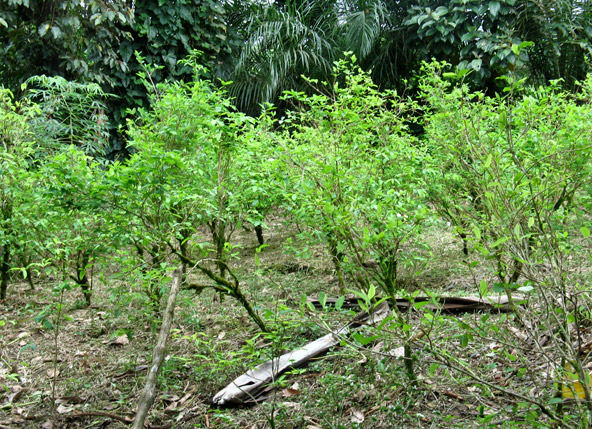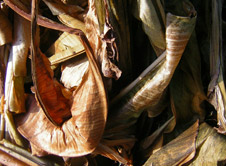
June 2007. Narino, Colombia. A coca field in Narino. Growers of coca tend to be poor as they are at the lowest rung of the drug production ladder. Colombia has a large population of people left out of the system. Both rebels and paramilitaries use the drug trade to fund their operations. American demand is what drives the whole process.
Photo: Phillip Robertson
Everyone in the state of Antioquia awoke to the news that an image of Christ had appeared on the wings of a moth. Our friend, the former AUC killer was an hour late for a meeting. Maybe he had changed his mind about talking. Maybe he was dead. In any case, there was nothing to do except wait on the roof and watch the Colombian newscasters compare portraits of Jesus to the markings on the televised insect. The tone was serious. No one on the television was joking about a potential miracle happening around the time of the Feast of the Virgin of Carmen. Carlos swore there was no resemblance, but he just didn't want to admit it. There was a resemblance, although it could also have been Mary trapped in the moth wings, covered in a dark hejab or an Iraqi girl framed by dun colored sand.
On the roof of the Almirante José Hotel, the air was warm and thick. Across the gulf of Urabá to the west, we could see the hills of the Darien gap, which leads to the border of Panama. Above us, the sky was another sea. Tropical storms born in the Atlantic were growing in strength as they made for the Caribbean coast of Colombia, where they would flood the streets and the fields. It was impossible to sit still and simply wait but there was nothing we could do. It was hard to know whether to be worried or not. "Man, I really think that he's not going to show. We scared him off," Carlos said when we were sitting at the table. The killer has always been friendly to us, but at this moment, he is down on his luck and paranoid; he could have changed his mind. In the past, when we called him, he arrived within minutes.
Lorenzo has come to trust me. All of this has taken some time to work out, over long nights of drinking. I asked questions only when he seemed relaxed enough to answer them and even then he was often careful not to say the names of the men he worked for.
He grew up poor in a mountain village and joined a left-wing revolutionary army called the ELP when he was eight after they promised to pay him a salary. Of course, what really happened was that he was taken as a child soldier by a group that would eventually be defeated by an up and coming right-wing organization. After growing up in the jungle and learning how to fight, Lorenzo ran away from the ELP when he was fifteen and then joined AUC in the mid-nineties. For assassins at the time, it was like Silicon Valley during the great boom of the nineties.
Lorenzo worked first as a soldier and later commanded 600 men in the Medio Atrato river zone, where he fought against the FARC. Lorenzo then worked for El Aleman-"the German"-the commander of the Bananero block, whose real name is Freddy Rendón. From 1997 until its dissolution in 2003, the Bananero block of the AUC controlled the territory where the Chiquita brands subsidiary, Banadex, had its vast banana and plantain operations.
During his time with them, the AUC, under the leadership of Salvatore Mancuso and the Castano brothers (Carlos and Fidel), committed some of the worst atrocities in the Americas, and despite a well-publicized government amnesty program, the AUC still exists in a clandestine way. Before turning in his rifle last year, Lorenzo was responsible for his own share of killings, a number of them in cold blood. Over the course of our two weeks in Urabá, it became clear that he had learned a great deal from his time working for the bananero block of the AUC. Lorenzo is a living archive of paramilitary data, and his commanders, the duros, the hard men at the top, trusted him with some of the most sensitive tasks.
Just as we were about to give up, Lorenzo appeared, smiling as if nothing was wrong. We found a table in the corner and I asked him about the drugs for weapons exchange and the Chiquita freighters. "Look, for every kilo of drugs they put in, they had to pay 500,000 pesos. If you're a drug trafficker, and I'm in control, you'd have to pay me. You have 20 kilos of coca, or you have some other cargo, and I own that region-you understand me? You pay me 500,000 pesos for me to ship those drugs as if they were mine, in the boats. You understand? Chiquita's boats. That's what the Bananero Block had going on here." Lorenzo watched the AUC load drugs onto Chiquita boats; he knew about it because he was there when it happened. "Look, there were drugs, and there were times that they sent drugs for weapons. They sent the kilos of drugs and from out there, those duros said we are going to send this many kilos of drugs and I need this many rifles," Lorenzo said.
What Lorenzo described was a successful scheme that allowed the AUC to act as a contraband freight consolidator. The AUC could ship their own cocaine on the company freighters or they could ship product belonging to someone else if they would pay a tax of roughly $250 per kilo, which works out to a quarter of the Colombian value of the brick. And the smuggling scheme was a direct side effect of gaining access to the port. Lorenzo insisted more than once that Chiquita employees knew about the cocaine because everyone in the chain was paid a percentage to keep quiet, including the freighter captains. To place a metric ton of someone else's product on a ship they did not own, the AUC would have made $500,000, not a bad haul for taking no real risk. And the paramilitaries received the money whether the product was intercepted or not. When they shipped their own cocaine, the AUC took the same risks as everyone else. Hiding cocaine in regular freighter traffic makes it hard to find. The freighters are enormous vessels.
Without access to the Chiquita port, the AUC couldn't have exported drugs and bought weapons so easily and could not have grown quite so fast as it did in the late nineties. It was a key part of their metabolism during that time-if you make money from exports, you need to get them to market so you can further expand the business. Chiquita after a hundred years in the banana trade understood this very well, and for the paramilitaries, using the port it was a straightforward decision based on necessity. Lorenzo belied that the AUC must have shipped tons of cocaine using this system, because it went on for years.
But did Chiquita know how its ports were being used? We asked him that question many times and his answers did not vary: "From Chiquita there had been people that knew that they were shipping drugs, employees. People trusted by them," he said. He was adamant; Chiquita employees knew about the drugs as well as the weapons, he explained.
On our last night in Turbo we went to drink a farewell beer at a place on the main drag. Lorenzo was nervous because he was not in his own neighborhood, but he was too polite to say that we picked a bad spot. In the neighborhood around his house, there are men endlessly riding around on bikes who watch out for him, let him know what's going on. We saw those men ride by, checking up on him. They all had the look of former paramilitaries with close-cropped haircuts and civilian clothes. Lorenzo leaned close to tell me that, given some time, he could find other AUC soldiers who could talk about the weapons and drugs for us, that he had some names, but that he had to be careful because some of these men were still active. Before long, the rains arrived with such force that the streets became riverbeds, torrents of mud-colored water coursing down them. Kids rode their bikes through the deluge sending rooster tails of water into the lightning-charged air.
 LEAD IMAGE: Dried banana leaves.
LEAD IMAGE: Dried banana leaves.Photo: Unknown
© Phillip Robertson, 2009-2014.
